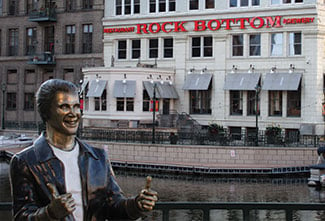
When coaching our customers through the sign design and installation process, we find ourselves educating our customers about best practices in sign design and placement. Designs that work on paper, may not be the best in practice. Here are a few simple, yet important, tips to keep in mind when it comes to digital signage design and new business sign design in general.
1. Viewing Distance
Start with your audience’s distance from your sign and then plan accordingly. The size of your lettering and height of the sign will be determined, in part, by the viewing distance. You’ll want to consider the amount of time your audience will have with your sign as well.
2. Viewing Angle
Consider the angles from which your audience will view your sign. As a viewer moves past your sign they will experience varying points of readability. Be sure to consider all angles and work with your sign provider to match the right sign to your location.
3. Exposure Time
Traveling in a car at 55 mph, your reader will have to read quickly, so the sign should be bright and easy to consume with simple letters that are large and have high contrast to the space around it.
4. Font Size
You’ll adjust your sign’s font size based on the distance from which the sign will be viewed. One inch of letter height for every ten feet of distance is a good general rule to follow. For example, if you need a sign to be legible from 200 feet, you’ll want to use letters to be 20 inches high.
5. Font Type
If your sign will include a script font, keep in mind that you’ll need to use a larger letter size for better legibility. The style and complexity of the font can affect legibility.
6. Color and Contrast
Without a doubt, the color of your sign background and characters and even the surrounding space will affect readability. We recommend higher contrast – black and white, for example, over two similarly shaded colors such as light blue and yellow. The higher the contrast between the letters and the background, the easier the sign is to read.
7. Lighting
Choose colors that will be most readable in the available light conditions. Darker colors, for example, are more visible in bright light and vice versa. When in doubt, consider a lighted sign that emits its own light or place your sign under direct lighting.
8. White or Negative Space
White or negative space is an important element to a finished piece in the art and design world. In the sign industry, overlooking the negative space in a design can sacrifice readability. Negative or white space is the shape of the space around your letters or your sign. It is not always white; think of it as the cushion around the content that adds emphasis. That space is a resting spot for the reader’s eye, and it signals where relevant images begin and where they end, allowing the reader to determine what is important to the message quickly.
9. Pixilation
If your sign is a digital signage system (also known as an electronic message center or EMC), the pixelation of the sign will be determined by viewing distance as well. Pixelation in digital signage are points of light that form an image when viewed together. The size of each pixel of light – 10mm, 12mm, 16mm or 19mm – in relation to the height of the characters and the viewing distance affects readability. We recommend a minimum viewing distance for each pixel size, following the rule that requires a smaller pixel for a shorter distance.

10. Placement
When we talk about placement, we are talking about a number of factors including where your sign is in relation to:
- Buildings
- Sidewalks
- Roadways
- And even other signs
Visual clutter around your sign can render your sign less legible. That means other signs, landscaping, traffic patterns can all keep your audience from viewing your sign as you intended. It’s best to place signs directly within the line of sight or perpendicular to it, instead of parallel to it. For example, a street sign is easier to find and read when placed directly above the lanes of traffic rather than on the street corner.
Sign Design Resources
 Before starting your signage project, it may be helpful to learn about your signage options and the process of getting a new business sign.
Before starting your signage project, it may be helpful to learn about your signage options and the process of getting a new business sign.
Visit this page to learn about the different types of signage available. For those looking for more in-depth information on the sign design and installation, we recommend downloading our Ultimate Guide to Business Signage.
This helpful guide covers:
- Types of business signs
- Prominent types of lighted signs
- Business sign construction options
- Business sign care
- And more!
Contact Lemberg's Local Sign Design Experts
These are guidelines and not hard fast rules. With so many variables, it’s important to work with your sign professional to determine the right sign for your brand, your location, your space, your audience and your budget. We’re here to help you navigate your choices. Contact Lemberg Signs & Lighting for more information.
